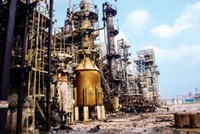Advertisement
Grab your lab coat. Let's get started
Welcome!
Welcome!
Create an account below to get 6 C&EN articles per month, receive newsletters and more - all free.
It seems this is your first time logging in online. Please enter the following information to continue.
As an ACS member you automatically get access to this site. All we need is few more details to create your reading experience.
Not you? Sign in with a different account.
Not you? Sign in with a different account.
ERROR 1
ERROR 1
ERROR 2
ERROR 2
ERROR 2
ERROR 2
ERROR 2
Password and Confirm password must match.
If you have an ACS member number, please enter it here so we can link this account to your membership. (optional)
ERROR 2
ACS values your privacy. By submitting your information, you are gaining access to C&EN and subscribing to our weekly newsletter. We use the information you provide to make your reading experience better, and we will never sell your data to third party members.
Safety
Deadly Fertilizer Explosion
Investigation: Safety board experts deploy to chaotic Texas disaster site
by Jeff Johnson
April 18, 2013
| A version of this story appeared in
Volume 91, Issue 16

Investigators from the federal Chemical Safety & Hazard Investigation Board (CSB) rushed to the scene of the April 17 deadly fertilizer facility fire and explosion that ripped apart the small Texas town of West, 15 miles north of Waco. They hope to pinpoint the cause of the West Fertilizer Co. accident that killed some dozen people, injured more than 150, and forced evacuations in the small town.
“The explosion caused huge off-site damage with many deaths and injuries,” says Daniel M. Horowitz, CSB managing director. “We have no choice but to throw everything at it. We have 12 investigators on-site as well as additional experts on fire origin, structural damage, and explosives.”
News videos of the explosion show a huge fireball and powerful explosion that some observers say felt like an earthquake—it registered 2.1 on the Richter scale. The plant was reported to store anhydrous ammonia for use in fertilizer, but that substance is highly unlikely to cause such an explosion, experts say.
A more likely culprit is ammonium nitrate, noted Daniel A. Crowl, a professor of chemical engineering and process safety at Michigan Technological University. “The type of explosion observed and the range of damage is much more consistent with an ammonium nitrate explosion,” he says, pointing to a long history of similar explosions.
However, when this story posted, it was unclear what chemicals were stored or used on-site and exactly what was done at the facility, Crowl stresses.
Filings with the state of Texas and the Environmental Protection Agency list the company as a storage facility that held up to 54,000 lb of anhydrous ammonia for sales to local farmers. In 2006, EPA fined the company $2,300 for failing to complete and file an adequate risk management plan, raising questions about what chemicals actually were being used on-site. Risk management plans require companies to list any hazardous chemicals they use and provide information on how they would respond to a facility accident.




Join the conversation
Contact the reporter
Submit a Letter to the Editor for publication
Engage with us on Twitter